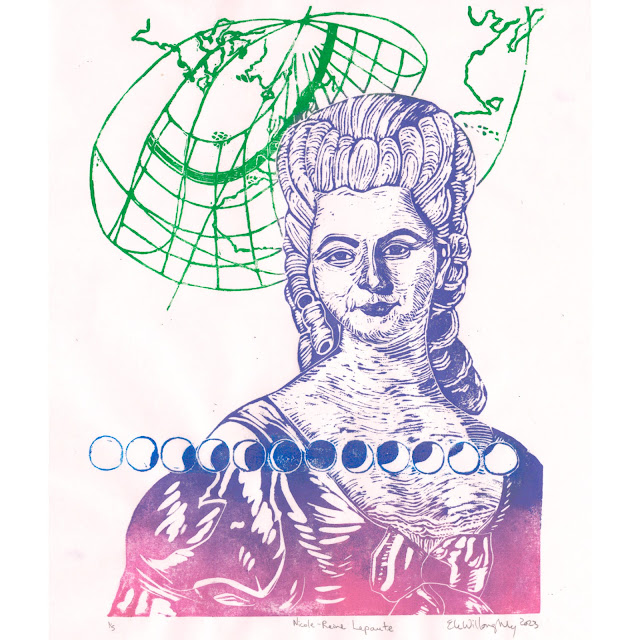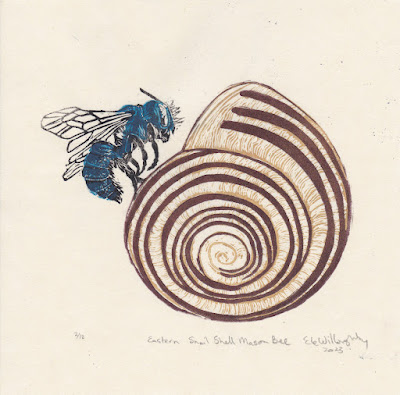I haven't kept up with posting all my recent prints, so today, we're playing catchup! I've been doing #printerSolstice so I have managed to make a print weekly tie to their prompts. This year the prompts are elements of art and design: value, form, line, balance, texture and upcoming are space, shape, contrast, proportion, unity, pattern and variety. I'm trying to interpret these prompts in light on my ongoing series of prints of various sorts. The first one, value (or the lightness and darkness of colours), I applied to another slightly sinister winter folktale: Jack Frost and made a print in tints and shades of cobalt blue.
 |
| Jack Frost, linocut on cardstock, 5" x 7" by Ele Willoughby, 2022 |
For form, I thought of Kepler and how he arrived at his laws from thinking about music and then the Platonic Solids!
 |
| Johannes Kepler, linocut, 11" x 14" on Japanese kozo paper, by Ele Willoughby 2023 |
This is my linocut of mathematician and astronomer Johannes Kepler (1571-1630). We remember him for his role in the Scientific Revolution, and his three laws of planetary motion in particular. His laws modified Copernicus’ heliocentric model; he replaced the circular orbits with elliptical ones & described velocities of planets. Today we know them as:
1) Planetary orbits are ellipses with the Sun as one of the foci (top magenta ellipse)
2) A line from Sun to planet sweeps out equal areas in equal time periods (middle ellipse)
3) The square of the planet’s orbital period (or year) is proportional to the cube of the semi-major axis (shown as the horizontal arrow in the bottom ellipse).
But, I find it fascinating- & important to note- that he came to these laws exploring mystical ideas about music, geometry and congruence with physical phenomena. Sometimes we tell simple, but misleading stories about scientific progress.
First he argued that the spacing of the 6 known planets from the Sun were related to the 5 Platonic solids, each encased in a sphere and nested one inside another. He had to order them selectively: octahedron, icosahedron, dodecahedron, tetrahedron and cube. He then related the size of the spheres to the orbital periods of the planets (Mercury, Venus, Earth, Mars, Jupiter and Saturn). But this formula was not precise enough…. But we can see this as the seed of his 3rd law. The gold shapes are the nested Platonic solids from his Mysterium Cosmographicum.
He also took the medieval idea of the “music of the spheres” literally and translated planetary angular speed as measured from the Sun as musical notes and finds that the minimum and maximum speeds of neighbouring planets approximate harmonies. Though unrelated to our modern ideas about our solar system these explorations of geometry and music ultimately lead to his correct models, which in turn were a significant steps towards Newton’s Law of Universal Gravitation.
Next came line, and I made it about the line traced by an eclipse:
 |
| Nicole-Reine Lepaute, linocut, 11" x 14" on Japanese kozo paper, by Ele Willoughby, 2023 |
This is my linocut portrait of Nicole-Reine Lepaute, née Étable de la Brière, (5 January 1723 – 6 December 1788). She was a French astronomer, mathematician and human computer. My print celebrates how she calculated the path of the solar eclipse of 1764. She also worked with Alexis Clairaut and Jérôme Lalande to much more precisely calculate the date of the return of Halley’s Comet. This is no mean feat when you realize this was essentially solving the notorious three-body by hand (as the gravitational pull of Jupiter and Saturn affect its orbit around the sun). They worked in parallel, calculating for 6 months straight, barely stopping to eat! She also produced astronomical almanacs from 1759 to 1783 and was also a member of the Scientific Académie de Béziers.
Some of the historic women of science whose names and achievements were recorded, are known to us because of their wealth and privilege. Though Nicole-Reine Lepaute was born in Luxembourg Palace, she was not an aristocrat; she was the sixth of nine children of the valet of the duchess de Barry and her sister. A bright child, she was self-taught and devoured all the books in the library. Her later friend and long-time collaborator, astronomer Jérôme Lalande wrote that she had "too much spirit not to be curious."
She married the royal clockmaker Jean-André Lepaute, in the Luxembourg Palace, in 1764. She became responsible for the household accounts but her marriage also allowed her to pursue her interest in mathematics and astronomy. She applied her skills to document, observe and calculate the workings of all her husband's inventions. The Académie des Sciences sent Lalande to inspect her husband's new type of pendulum clock. The three worked on the theory of clockmaking and added to her husband's "Traité d'horlogerie," which he had published in 1755. Though she was not included as a co-author, Lalande was nothing but praise for her, writing, "Madame Lepaute computed for this book a table of numbers of oscillations for pendulums of different lengths, or the lengths for each given number of vibrations, from that of 18 lignes, that does 18000 vibrations per hour, up to that of 3000 leagues"
Though Newton's Law of Universal Gravitation, published in 1687, allowed astronomers to calculate planetary orbits around the sun, to do so they considered only the two bodies: the mass and position of a single planet and the sun. The truth is more complex, because all masses exert gravity, and as soon as we introduce even a third mass there is no general closed-form solution and some systems are even chaotic. The first problem studied was the Sun-Earth-Moon 3-body problem, which Newton could not solve and succeeding generations continued to pursue. Early physicists became so frustrated that they began to doubt Newton's Law of Universal Gravitation. Renown mathematician Leonard Euler even wrongly argued against the inverse square law. Being able to accurately predict the Moon's orbit had huge implications for navigation and determination of longitude at sea. Competing polymaths Jean le Rond d'Alembert and Alexis Clairaut each presented their analyses of the problem to the Académie Royale des Sciences in 1747. Clairaut had found a brilliant approximate solution to the 3-body problem for which he received the 1750 prize of the St Petersburg Academy for his essay "Théorie de la lune".
In 1757, Lalande decided he improve on the predictions of a different 3-body problem: the return of Halley's Comet, last seen in 1682. Because the gravitational pull of Jupiter and Saturn cannot be neglected, Halley himself was only able to calculate that the comet would return "around the end of the year 1758 or the beginning of the next." He enlisted the help of Clairaut and Lepaute. The divided up the calculations required and worked in parallel for more than 6 months, barely even stopping to eat! They were in a race to make their prediction before the comet itself arrived. By November 1758 they gave a two-month window for comet's perihelion (closed point to the sun) of the 15th of March to the 15th of May, centered around the 13th of April 1759. They missed the comet's arrival, the 13th of March, 1759 by only a couple of days. Sour grapes Jean d'Alembert griped that their work was "more laborious than deep". In fact, their heroic efforts were a huge technical feat and ten-fold improvement on Haley's vague two-year window. Their error was only due to employing the less-than-accurate accepted masses for Jupiter and Saturn. Notorious ladies' man Clairaut unfortunately removed any mention of Lepaute from his 1760, "Théorie du mouvement des comètes", alledgedly to please another woman, whereas in Lalande's "Théorie des Comètes" he insists they could never have made the calculations without her.
Lepaute went on to collaborate with Lalande and his calculations for decades. In 1759 Lalande became the director of the Académie des Sciences astronomical almanac Connaissance des Temps (Knowledge of the times) and appointed Lepaute as his assistant. He prepared computing plans and she did the calculations for the almanac. Her work included calculations on a 1762 comet, and a table of parallactic angles, work on the Éphémerides, annual guides for astronomers and navigators, calculating the daily position of Saturn from 1775 to 1784 (for the seventh volume, in 1774). She calculated on her own the daily positions of the Sun, Moon and planets for the eighth volume (in 1784).
In 1762 she calculated the exact time and path of the annular solar eclipse of 1st of April, 1764. Under her own name, she published a map which showed the eclipse's extent over Europe (shown in green in my print), as well as the its successive phases in 15-minutes intervals as would be visible over Paris (shown in blue in my print).
She and her husband were childless but adopted his nephew, Joseph Lepaute Dagelet in 1768 and she trained him as a mathematician and astronomer. He became a professor and was inducted in the French Royal Academy of Sciences in 1785.
Despite how vital, and Lalande's vocal appreciation, her work remained largely unrewarded and unrecognized during her lifetime. She worked as computer for Lalande for 15 years while he was a professor and director of the Paris Observatory. She did became a member of the distinguished Scientific Academy of Béziers in 1761, and calculated the ephemeris of the 1761 transit of Venus for them. Her eyesight after decades of calculation deteriorated to the point that she had to retire in 1783. She spent the end of her life caring for her terminally ill husband. After her death in 1788, Lalande wrote a biography of her contributions which he included in his Astronomical Bibliography. Both an asteroid (7720 Lepaute) and a lunar crater have posthumously been named in her honour.
For Balance, I made my portrait of Zhang Heng (see previous post).
For Texture, I made a print of an Eastern Snail Shell Mason Bee, Osmia conjuncta.
 |
| Eastern Snail Shell Mason Bee, linocut 8" x 8" on Japanese kozo paper, by Ele Willoughby, 2023 |
The Packer Lab at York University posted an image of this mason bee, Osmia conduct, and explained that these adorable little blue snail shell nesting bees had now been observed in Canada (southern Ontario) and to be honest, I'm completely obsessed with the idea. I think it's the cutest thing I've ever heard. Apparently, they think these bees have become more common here because there are now so many of the Cepaea snails, introduced from Europe. So, while I couldn't find any images of this bee nesting, I illustrated it with a Cepaea shell. You can find images and video of other Osmia bees nesting in snail shells online. Many thanks to the friendly and helpful Entomology Twitter folks who helped me track down the right type of snail shell and even introduced me to researchers who said they would try to get video of these cuties next field season!
I will miss Science Twitter when it's gone.
References for scientist bios
Johannes Kepler, Wikipedia, accessed January 2023
Nicole-Reine Lepaute, Wikipedia, accessed January 2023
Jérôme Lalande, Wikipedia, accessed January 2023
Alexis Clairaut, Wikipedia, accessed January 20223
Lynn, W. T. (2 January 1911). "Madame Lepaute". The Observatory. 34: 77–78. Bibcode:1911Obs....34...87L.
Bernardi, Gabriella (21 March 2016). The Unforgetten Sisters: Female Astronomers and Scientists before Catherine Herschel. Springer. pp. 121–127. ISBN 9783319261270.
De La Lande, Jérôme (1803). Bibliographie astronomique avec l'histoire de l'astronomie depuis 1871 jusqu'à 1802 (in French). Paris: Imprimerie de la République. ISBN 978-2329549170. Archived from the original on 4 May 2010.
Connor, Elisabeth (November 1944). "Mme. LePaute, An Eighteenth Century Computer". Astronomical Society of the Pacific Leaflets. 4 (189): 314–321. Bibcode:1944ASPL....4..314C.









No comments:
Post a Comment